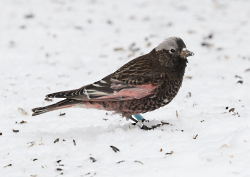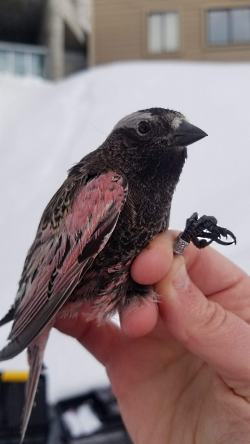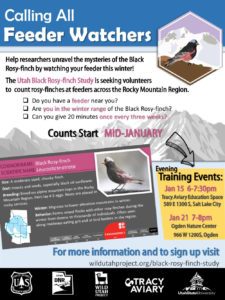
Courtesy & © Janice Gardner, Photographer
 Newly Banded Adult Male
Newly Banded Adult Male
Black Rosy-Finch
Courtesy & © Kim Savides
 Rosy-Finch Study, Wild Utah Project High in the snow-covered mountains of Northern Utah, Kim Savides, a graduate student in the Department of Wildland Resources at Utah State University waits for the daily avalanche report during winter months. If favorable, she ventures out to remote bird feeders in hopes of finding black rosy-finches.
Rosy-Finch Study, Wild Utah Project High in the snow-covered mountains of Northern Utah, Kim Savides, a graduate student in the Department of Wildland Resources at Utah State University waits for the daily avalanche report during winter months. If favorable, she ventures out to remote bird feeders in hopes of finding black rosy-finches.
The finches thrive in bad weather. When it’s a clear, sunny day Savides knows her likelihood of seeing a finch is slim. But on nasty, snowy, windy days she can count on seeing hundreds of the finches around the feeders.
Most of the bird feeders are on Utah’s beautiful ski resorts such as Alta and Powder Mountain. On blizzard-like days when skiers are choosing to staying home, Savides is heading up the slopes.
Clark Rushing, assistant professor in Department of Wildland Resources in the Quinney College of Natural Resources and principal investigator on the project explains, “To catch these black rosy-finches, we’re travelling to locations when the weather is at its worst. They are extremely hardy birds, how they survive in those conditions is pretty astounding. They are small birds weighing only a few ounces.”
Due to the warming temperatures, the black rosy-finch populations may be at risk.
Scientists fear the finch numbers may be decreasing, based on the reports from bird watchers who say they are seeing much less of the attractive bird. Researchers are concerned it may be a result of climate change.
Rushing explains, “The black rosy-finch has a small breeding distribution confined to very high elevation sites. Climate change may drive this species to smaller and smaller population sizes and possible extinction because as climate warms these sites, where the finches can breed, they will get smaller and smaller. The birds could eventually get pushed off the tops of the mountains with nowhere to go.”
According to the Wild Utah Project, “The black rosy-finch is one of the least-understood birds in North America. We understand little about its reproduction, population status, survival rates, or migratory tendencies.” Without this information wildlife managers can do little to help conserve its population.
Savides’ goal is to assist in gathering enough data so wildlife managers may begin to understand the life cycle of the finch and plan for conservation efforts.
Her project began by setting up mist nets around the feeders to catch the birds. Once caught, the finches were gently held while a micro-chip bracelet was attached to their legs.
Each time one of the tagged finches approaches a feeder, equipped with a radio frequency reader, the bird’s visit is logged.
The finches tagged last year are now returning. The data is beginning to be gathered.
Recognizing the amount of data needed, researchers have expanded the data gathering to include citizen scientists. These are residents of Utah who volunteer to be trained to identify the black rosy-finches. In the winter when the birds come down to lower elevations, in certain parts of the state, residents can report when they see the finches.
Any resident interested in becoming a citizen scientist can go to the Wild Utah Project website and receive more information.
As more and more data are gathered, researchers and wildlife managers can begin understanding the phenology of when the finches come down to lower elevations, when they return to higher elevations to breed, and how likely they are to survive from one year to the next. This knowledge could help with conservation efforts.
This is Shauna Leavitt and I’m Wild About Utah.
Credits:
Photos: Courtesy & © Janice Gardner
Courtesy & Copyright © Kim Savides,
Courtesy & Copyright © Wild Utah Project
Lead Audio: Courtesy and © Kevin Colver
Text: Shauna Leavitt, Utah Cooperative Fish and Wildlife Research Unit, Quinney College of Natural Resources, Utah State University
Sources & Additional Reading
Greene, Jack, Rosy Finches, Wild About Utah, March 11, 2019, https://wildaboututah.org/rosy-finches/
Gardner, Janice, Rosy Finch Study, Wild Utah Project, Fall/Winter 2019/2020, https://sagelandcollaborative.org/rosy-finch/ [link updated January 2024 – note WildUtahProject.org transformed to SagelandCollaborative.org]
Strand, Holly, A Big Year in Utah, Wild About Utah, October 27, 2011, https://wildaboututah.org/a-big-year-in-utah/
Black Rosy-Finch Identification, All About Birds, Cornell Lab of Ornithology, Cornell University, https://www.allaboutbirds.org/guide/Black_Rosy-Finch/id
Gray-Crowned Rosy-Finch Identification, All About Birds, Cornell Lab of Ornithology, Cornell University, https://www.allaboutbirds.org/guide/Gray-crowned_Rosy-Finch/id
Black Rosy Finches, Utah Division of Wildlife Resources, Utah Department of Natural Resources, https://fieldguide.wildlife.utah.gov/?species=leucosticte%20atrata
Gray-crowned Rosy Finches, Utah Division of Wildlife Resources, Utah Department of Natural Resources, https://fieldguide.wildlife.utah.gov/?Species=Leucosticte%20tephrocotis
Black Rosy Finches, UtahBirds.org, https://www.utahbirds.org/birdsofutah/Profiles/BlackRosyFinch.htm
Gray-crowned Rosy Finches, UtahBirds.org, https://www.utahbirds.org/birdsofutah/ProfilesD-K/GrayCrownedRosyFinch.htm
Black & Gray Rosy Finches, Tim Avery Birding, http://www.timaverybirding.com/photos/thumbnails.php?search=black+Rosy-Finches&album=search&title=on [Link updated January 2024]
Phenology Tools for Community Science
USA National Phenology Network, https://www.usanpn.org/
Nature’s Notebook Education Program, US National Phenology Network, https://www.usanpn.org/nn/education
North American Bird Phenology Program, USGS Patuxent Wildlife Research Center, https://www.pwrc.usgs.gov/bpp/BecomeAParticipant.cfm
eBird, https://www.ebird.org/
iNaturalist, https://www.inaturalist.org/
